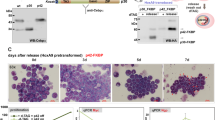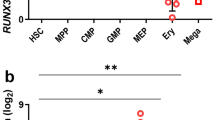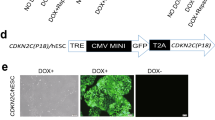Abstract
HMG-box containing protein 1 (HBP1) is a member of the high mobility group (HMG) of chromosomal proteins. Since HBP1 exhibits tumor-suppressor activity in nonmyeloid tissues, we examined the effects of ectopic overexpression of HBP1 upon the growth and differentiation of myeloid cells. We prepared transient and stable transfectants of the myeloblast cell line K562, which overexpress HBP1 mRNA and protein. HBP1 transfectants displayed slower growth in cell culture and reduced colony formation in soft agar, retardation of S-phase progression, reduced expression of cyclin D1 and D3 mRNAs and increased expression of p21 mRNA. HBP1 transfectants also underwent increased apoptosis, as demonstrated by morphology and binding of Annexin V. Fas ligand mRNA levels were increased in HBP1 transfectants, suggesting involvement of the Fas/Fas ligand pathway. HBP1 overexpression enhanced differentiation of K562 cells towards erythroid and megakaryocyte lineages, as evidenced by increased hemoglobin and CD41a expression. Overexpression of HBP1 modulated mRNA levels for myeloid-specific transcription factors C/EBPα, c-Myb, c-Myc, and JunB, as well as lineage-specific transcription factors PU.1, GATA-1, and RUNX1. These findings suggest that in myeloid cells HBP1 may serve as a tumor suppressor and a general differentiation inducer and may synergize with chemical differentiating agents to enhance lineage-specific differentiation.
This is a preview of subscription content, access via your institution
Access options
Subscribe to this journal
Receive 12 print issues and online access
$259.00 per year
only $21.58 per issue
Buy this article
- Purchase on Springer Link
- Instant access to full article PDF
Prices may be subject to local taxes which are calculated during checkout










Similar content being viewed by others
Accession codes
References
Lesage F, Hugnot J-P, Amri E-Z, Grimaldi P, Barhanin J, Lazdunski M . Expression cloning in K+ transport defective yeast and distribution of HBP1, a new putative HMG transcriptional regulator. Nucleic Acids Res 1994; 22: 3695–3688.
Landsman D, Bustin M . A signature for the HMG-1 box DNA-binding proteins. Bioessays 1993; 15: 539–546.
Grosschedl R . Higher-order nucleoprotein complexes in transcription: analogies with site-specific recombination. Curr Opin Cell Biol 1995; 7: 362–370.
Tjian R, Maniatis T . Transcriptional activation: a complex puzzle with few easy pieces. Cell 1994; 77: 5–8.
Wolffe AP . Architectural transcription factors. Science 1994; 264: 1100–1101.
Arie T, Christiansen SK, Yoder OC, Turgeon BG . Efficient cloning of ascomycete mating type genes by PCR amplification of the conserved MAI HMG Box. Fungal Genet Biol 1996; 21: 118–130.
Sugimoto A, Lino Y, Maeda T, Watanabe Y, Yamamoto M . Schizosaccharomyces pombe ste11+ encodes a transcription factor with an HMG motif that is a critical regulator of sexual development. Genes Dev 1991; 5: 1990–1999.
Van De Wetering M, Oostewegel M, Dooijes D, Clevers H . Identification and cloning of TCF-1, a T lymphocyte-specific transcription factor containing a sequence-specific HMG box. EMBO J 1991; 10: 123–132.
Alexander-Bridges M, Dugast I, Ercolani L, Giere L, Nasrin N . Multiple insulin-response elements regulate transcription of the GAPDH gene. Adv Enzyme Regul 1992; 32: 149–159.
Lin KM, Zhao WG, Bhatnagar J, Zhao WD, Lu JP, Simko S et al. Cloning and expression of human HBP1, a high mobility group protein that enhances myeloperoxidase (MPO) promoter activity. Leukemia 2001; 15: 601–612.
Lavender P, Vandel L, Bannister AJ, Kouzarides T . The HMG-box transcription factor HBP1 is targeted by the pocket proteins and E1A. Oncogene 1997; 14: 2721–2728.
Tevosian SG, Shih HH, Mendelson KG, Sheppard KA, Paulson KE, Yee AS . HBP1: a HMG box transcriptional repressor that is targeted by the retinoblastoma family. Genes Dev 1997; 11: 383–396.
Shih HH, Tevosian SG, Yee AS . Regulation of differentiation by HBP1, a target of the retinoblastoma protein. Mol Cell Biol 1998; 18: 4732–4743.
Gartel AL, Goufman E, Tevosian SG, Shih H, Yee AS, Tyner AL . Activation and repression of p21(WAF1/CIP1) transcription by RB binding proteins. Oncogene 1998; 17: 3463–3469.
Zhuma T, Tyrrell R, Sekkali B, Skavdis G, Saveliev A, Tolaini M et al. Human HMG box transcription factor HBP1: a role in hCD2 LCR function. EMBO J 1999; 18: 6396–6406.
Lemercier C, Duncliffe K, Boibessot I, Zhang H, Verdel A, Angelov D et al. Involvement of retinoblastoma protein and HBP1 in histone H1(0) gene expression. Mol Cell Biol 2000; 18: 6627–6637.
Swanson KA, Knoepfler PS, Huang K, Kang RS, Cowley SM, Laherty CD et al. HBP1 and Mad1 repressors bind the sin3 corepressor PAH2 domaine with opposite helical orientations. Nat Struct Mol Biol 2004; 11: 738–746.
Shih HH, Xiu M, Berasi SP, Sampson EM, Leiter A, Paulson KE et al. HMG box transcriptional repressor HBP1 maintains a proliferation barrier in differentiated liver tissue. Mol Cell Biol 2001; 21: 5723–5732.
Smith JM, Bowles J, Wilson M, Koopman P . HMG box transcription factor gene HBP1 is expressed in germ cells of the developing mouse testes. Dev Dyn 2004; 230: 366–370.
Xiu M, Kim J, Sampson E, Huang CY, Davis RJ, Paulson KE et al. The transcriptional repressor HBP1 is a target of the p38 mitogen-activated protein kinase pathway in cell cycle regulation. Mol Cell Biol 2003; 23: 8890–8901.
Sampson EM, Haque ZK, Ku MC, Tevosian SG, Albanese C, Pestell RG et al. Negative regulation of the Wnt-beta-catenin pathway by the transcriptional repressor HBP1. EMBO J 2001; 20: 4500–4511.
Berasi SP, Xiu M, Yee AS, Paulson KE . HBP1 repression of the p47phox gene: cell cycle regulation via the NADPH oxidase. Mol Cell Biol 2004; 24: 3011–3024.
Yee AS, Paulson EK, McDevitt MA, Rieger-Christ K, Summerhayes I, Berasi SP et al. The HBP1 transcriptional repressor and the p38 MAP kinase: unlikely partners in G1 regulation and tumor suppression. Gene 2004; 336: 1–13.
Bergh G, Ehinger M, Olofsson T, Baldetorp B, Johnsson E, Brycke H et al. Altered expression of the retinoblastoma tumor-suppressor gene in leukemic cell lines inhibits induction of differentiation but not G1-accumulation. Blood 1997; 89: 2938–2950.
Munoz-Alonso MJ, Acosta JC, Richard C, Delgado MD, Sedivy J, Leon J . p21Cip1 and p27Kip1 induce distinct cell cycle effects and differentiation programs in myeloid leukemia cells. J Biol Chem 2005; 280: 18120–18129.
Labbaye C, Valtieri M, Barberi T, Meccia E, Masella B, Pelosi E et al. Differential expression and functional role of GATA-2, NF-E2, GATA-1 in normal adult hematopoiesis. J Clin Invest 1995; 95: 2346–2358.
Elagib KE, Racke FK, Mogass M, Khetawat R, Delehanty LL, Goldfarb AN . RUNX1 and GATA-1 coexpression and cooperation in megakaryocytic differentiation. Blood 2003; 101: 4333–4341.
Keeshan K, Santilli G, Corradini F, Perrotti D, Calabretta B . Transcription activation function of C/EBPalpha is required for induction of granulocytic differentiation. Blood 2003; 102: 1267–1275.
Yang MY, Liu TC, Chang JG, Lin PM, Lin SF . JunB gene expression is inactivated by methylation in chronic myeloid leukemia. Blood 2003; 101: 3205–3211.
Bakiri L, Lallemand D, Bossy-Wetzel E, Yaniv M . Cell cycle-dependent variations in c-Jun and JunB phosphorylation: a role in the control of cyclin D1 expression. EMBO J 2000; 19: 2056–2068.
Rosson D, O'Brien TG . Constitutive c-myb expression in K562 cells inhibits induced erythroid differentiation but not tetradecanoyl phorbol acetate-induced megakaryocytic differentiation. Mol Cell Biol 1995; 15: 772–779.
Clement M-V, Hirpara JL, Chawdhury S-H, Pervaiz S . Chemopreventive agent Resveratrol, a natural product derived from grapes, triggers CD95 signaling-dependent apoptosis in human tumor cells. Blood 1998; 92: 9996–1002.
Kohmura K, Miyakawa Y, Kawai Y, Ikeda Y, Kizaki M . Different roles of p38 MAPK and ERK in STI571-induced multi-lineage differentiation of K562 cells. J Cell Physiol 2004; 198: 370–376.
Radomska HS, Huettner CS, Zhang P, Cheng T, Scadden DT, Tenen DG . CCAAT/enhancer binding protein alpha is a regulatory switch sufficient for induction of granulocytic development from bipotential myeloid progenitors. Mol Cell Biol 1998; 18: 4301–4314.
Koike M, Tasaka T, Spira S, Tsuruoka N, Koeffler HP . Allelotyping of acute myelogenous leukemia: loss of heterozygosity at 7q31.1 (D7S486) and q33-34 (D7S498, D7S505). Leuk Res 1999; 23: 307–310.
Acknowledgements
This work was supported by a VA Merit grant to GEA.
Author information
Authors and Affiliations
Corresponding author
Additional information
Supplementary Information
Supplementary Information accompanies the paper on the Leukemia website (http://www.nature.com/leu).
Supplementary information
Rights and permissions
About this article
Cite this article
Yao, C., Works, K., Romagnoli, P. et al. Effects of overexpression of HBP1 upon growth and differentiation of leukemic myeloid cells. Leukemia 19, 1958–1968 (2005). https://doi.org/10.1038/sj.leu.2403918
Received:
Accepted:
Published:
Issue Date:
DOI: https://doi.org/10.1038/sj.leu.2403918
Keywords
This article is cited by
-
HBP1-mediated transcriptional repression of AFP inhibits hepatoma progression
Journal of Experimental & Clinical Cancer Research (2021)
-
MDM2 promotes genome instability by ubiquitinating the transcription factor HBP1
Oncogene (2019)
-
The HMG box transcription factor HBP1: a cell cycle inhibitor at the crossroads of cancer signaling pathways
Cellular and Molecular Life Sciences (2019)
-
ALK positively regulates MYCN activity through repression of HBP1 expression
Oncogene (2019)
-
HMG-box transcription factor 1: a positive regulator of the G1/S transition through the Cyclin-CDK-CDKI molecular network in nasopharyngeal carcinoma
Cell Death & Disease (2018)



